Readers who love—really love—books, who take special care in arranging them on their shelves, may at first glance find Rosamond Purcell’s artwork somewhat off-putting. The image above, titled “Book/nest,” is taken from Bookworm (Quantuck Lane Press, 2006), a collection of Purcell’s photos and collages of books that are in the process of being slowly destroyed by forces of nature. Included in Bookworm are images of weather-beaten novels, books that were buried in mud, partially burned books, waterlogged books, and even a nineteenth-century French economics textbook that has been eaten by termites. Purcell writes that many of the books she has photographed are now in her studio in Arlington, Massachusetts. Although they are almost impossible to open and can no longer be read, “the sight of these books comforts me,” she writes. “A book that is still a book but cannot be read imparts peace and promise.” Despite the miserable condition of the volumes she chooses to photograph, Purcell says that she, too, loves books. “I love them whole and unprovoked. I cherish them in perfect condition and care, too, for the not quite pristine,” she writes. “I pillage only those books already in an outlaw condition, those visited by termites, silverfish, mice, moths and beetles, damp, mold, rot, or fire. The tenacity of pages and bindings to survive such assaults seems miraculous.” In his introduction to Bookworm, Sven Birkerts, the editor of AGNI, writes that the “vivid illumination of damage” in Purcell’s work “isolates and heightens the idea of the book as material object. We are reminded that this emblem of mental life is subject like any other thing to the processes of erosion and decay.”









